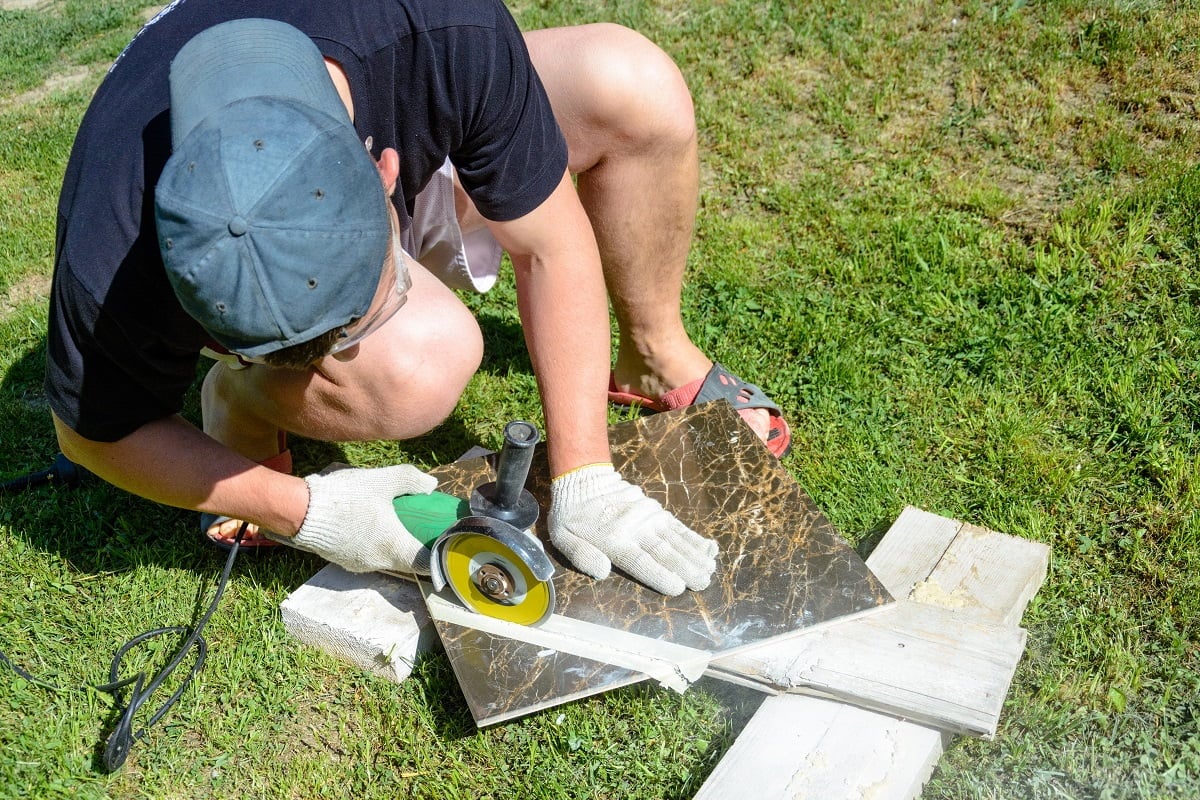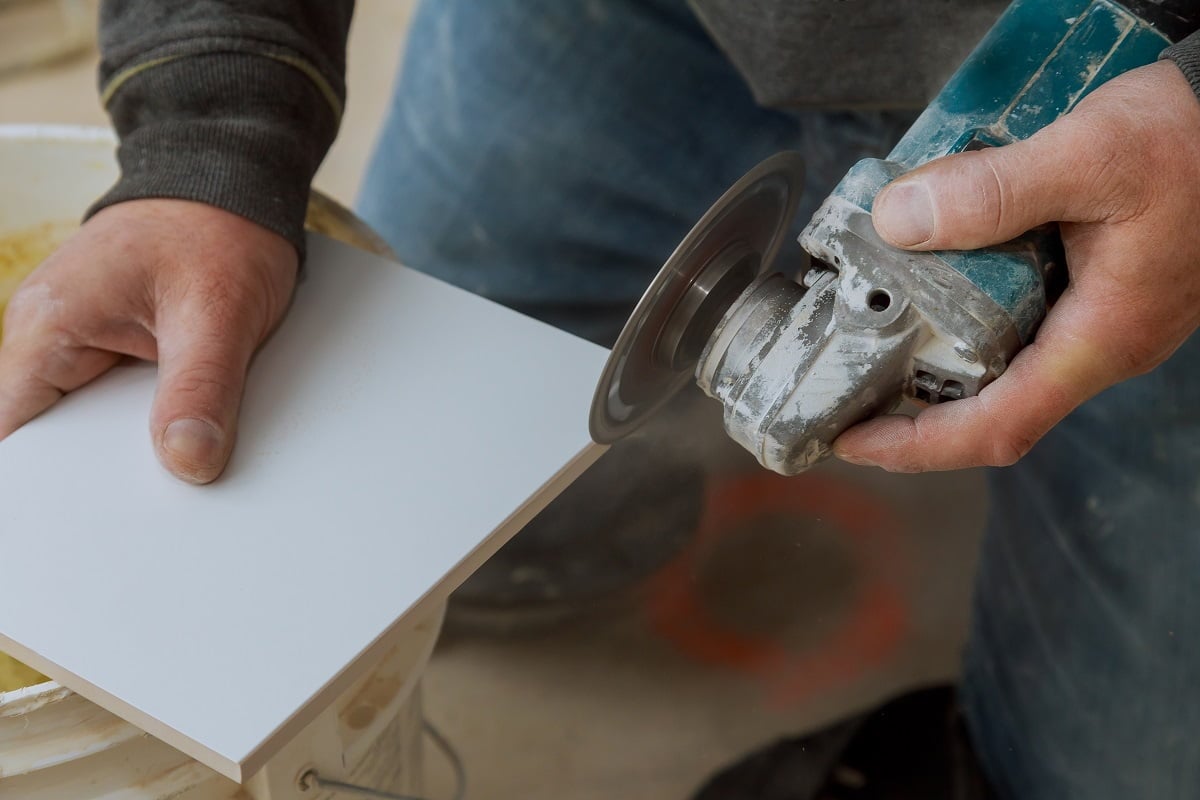There are different types of angle grinder discs, such as diamond-tipped, serrated blades, etc., which can be used for tile cutting. However, choosing the right one for the purpose will mainly depend on the tile material.

Picture this: you need to resize a few tiles for your DIY kitchen or bathroom renovation, but buying a wet saw is too expensive an option. You ask a friend for help, who hands you an angle grinder. Sounds weird, right?
But angle grinders can help you with tile cutting, provided you have the right disc attachment for the tile material. And in the following sections, we will tell you all about how to choose it.
What Is An Angle Grinder After All?

An angle grinder is a power tool that can be either corded or cordless (battery-powered), typically used for cutting, smoothing rough edges, grinding, and finishing metals. It’s equipped with a rotating abrasive disc, which performs all these tasks.
And as you may have already figured out, there are different types of discs, depending on the type of material you want to work with. We will talk about them in a later section.
Used for both residential and commercial purposes, angle grinders come in handy for different tasks, including:
- Sharpening gardening mower and shear blades
- Deburring steel frames
- Cutting protruding metal pieces
- Cutting ceramic, natural stone, and porcelain tiles
Which Angle Grinder Should You Use For Cutting Tiles?
Although angle grinders may not be the perfect tool for cutting tiles, the good news is they do the job pretty well. Moreover, there are different discs available for the job, which we’ve listed below.
1. Stone Cutting Disc
Stone discs or blades are the most affordable choice, suitable for users who don’t really need a lot of precision while cutting tiles. These discs make thick cuts and generate a lot of dust, so you should always use them outdoors and wear proper protective gear to protect your eyes and nose.
Another thing to note is that a stone grinding disc isn’t very durable either, so you need to constantly keep an eye on it. The moment you notice the blade chipping, replace it with a new one.
2. Steel Disc
A steel disc is undoubtedly one of the most reliable options to achieve satisfactorily clean cuts, thanks to the diamond coating on it. In other words, a steel blade is essentially a diamond-tipped blade that can take on heavy-duty tile cutting.
These discs make it easier to make both curved and straight cuts on tiles without straining your nerves too much. Although they are more durable than their stone counterparts, their lifespan will ultimately depend on the intensity and frequency of the cutting.
3. Continuous Dry Cutting Discs
Another option in the diamond-tipped category is the continuous dry-cutting disc, which is a solid disc best suited for edging the tiles with straight cutting. A pro tip- wet the tile with a spray gun from time to time to help the blade cool down and prevent it from overworking.
4. Diamond Tile Saw Blades
As the name may have already suggested, diamond saw blades can cut through tiles made from glass, ceramic, natural stone, porcelain, granite, etc. In fact, the best diamond tile saw blades are extremely sharp to provide the smoothest of cuts without chipping.
Many users who use angle grinders for cutting ceramic tiles (or any other type, for that matter) consider these blades to be the best, as they can cut even the toughest tile. But these high-power blades tend to be more expensive than the other types.
Furthermore, diamond saw blades can be categorized into dry and wet blades. While the former can work on dry surfaces, the latter will require the surface to be sprayed down with water at regular intervals. This helps to cool their core, making them perform longer without any significant issues when used properly.
5. Serrated Blades
If you aren’t particularly looking for a smooth cut on your tiles, then a serrated blade is a good option to go for. But that’s not the only advantage it provides, as serrated blades are extremely helpful when it comes to cutting concrete tiles.
Likewise, they are a preferred choice for cutting tiles made of materials like natural stone, which are harder than their ceramic counterparts.
6. Carbide-Tipped Blades
These blades offer you a decent mix of price and performance, as they generate satisfactory cutting power without burning a hole in your pocket.
7. Abrasive Wheels
Abrasive wheels are perhaps the cheapest option out there; however, the low price comes at the cost of low durability. But one benefit of these blades is they are compatible with most materials.
Best Angle Grinder Discs On The Market Right Now
Now that you have a fair idea about the different types of angle grinder discs, let us quickly take you through some of the best models on the market. You will see that all of them come under the diamond blade category, as most professionals recommend this type for cutting ceramic tile with the best results.
1. Adust 4.5-Inch Diamond Tile Blade
First up is the Adust 4.5-inch diamond tile blade, which is a preferred choice for cutting porcelain tiles. However, it also works well for ceramic, slate, marble, and other types of natural stone tiles. With a super thin turbo mesh rim and X-tooth design, it can provide faster and cleaner cuts with minimal chipping for your bathroom or kitchen tiles.
Moreover, it weighs a little more than 12 ounces, so you can rest assured that it won’t add much to the overall weight of your angle grinder. It’s also one of the most durable options on the market today for both professionals and DIYers.
2. Casaverde 4.5-Inch Super Thin Blade
Yet another angle grinder blade that’s worth considering is this unit from Casaverde, which offers chip-free cuts even on the toughest tiles. It facilitates dry and wet cutting alike, and a special heat-treat function keeps the temperature down when dry cutting for longer periods.
Users have liked how this unit is compatible with different materials like reinforced concrete and metals without compromising on a smooth finish. And if you’re wondering what angle grinder disc for wood will work best, then this unit can be a suitable answer to that, too.
3. Rok 4 ½-Inch Diamond Saw Blade Set
For people who may want to get their hands on a cost-effective blade set, Rok has got the perfect solution. According to the brand, this pack of 3 blades is suitable for making straight as well as angle cuts on varied materials, including granite, marble, ceramics, and concrete.
Each unit is equipped with a 1-inch turbo cutting rim that takes care of speed and precision, no matter if it’s a wet or dry cutting job. However, some users complain that the blades may not be very effective for longer cutting tasks.
Some Other Tips To Choose The Right Tile Cutting Blade
1. Size
Aside from the type of blade, you should consider the size (diameter) of the blade, as a bigger blade will easily cut more surface in one go.
2. Shape
Grinder blades come in different shapes, with square, rectangle, and segmented variants being the most commonly used ones. And each one brings different benefits and some drawbacks. For instance, squared-shaped tiles make it easier to perform straight cuts, but they may not be very useful for making curved cuts.
Rectangular blades, on the other hand, can be the perfect bet to make long, uninterrupted cuts, thanks to their larger surface area. However, they don’t score very high in terms of precision.
How To Use An Angle Grinder For Cutting Tiles?

The Preparation
Before starting with the job, ensure that you have the right tool and blade for the purpose.
For the unversed, angle grinders come in different variations, but the electric-powered ones are more popular, especially for standard DIY tile cutting and similar tasks. This is mainly because they can cover a larger area without requiring too much effort from the user.
Electric angle grinders are further divided into corded and cordless models, and you can choose one according to your needs and budget.
As for the tile cutter blade, it should be picked according to the material you will be working with. While a diamond-tipped blade with a smooth edge is considered most suitable to cut ceramic tiles, you can achieve cleaner cuts with notched blades for porcelain tiles.
After this is done, the next important thing is to wear adequate safety gear like work gloves, safety goggles, and a dust mask. Otherwise, you will expose yourself to injuries from the moving blade and flying debris from the tiles.
You can also use a pair of earplugs, as tile cutting generally produces a lot of noise, irrespective of the material. And now that the preparation is over, it’s time to get down to business!
Step 1
Start by securing the ceramic or porcelain tile to the work surface using clamps so that it doesn’t move through the cutting process. Dedicate adequate time to this step; otherwise, you will invariably risk injuring yourself, damaging the workspace, and messing up the cut itself.
Step 2
Once you’re sure that the tile is properly secured on the work surface, draw an outline of the cut on the tile. And if you haven't measured the area where the tile is to be set, this is the time to do it, as you need to cut the tile according to that measurement.
Depending on your needs, the cut outline can be of any shape, but always ensure that its perimeter is protected with mask tape to prevent chipping from the edges.
Step 3
Begin cutting the tile by holding the grinder at an angle most suitable for the cut. Straight cuts are better achieved by keeping the blade straight while making curves will require you to hold the tool at an angle. In fact, an angle grinder can perform better than a wet saw when it comes to angled cuts.
Keeping the blade vertically along the marked area will help you cut directly into the surface of the tile. On the other hand, a horizontal blade movement that’s kept flush with the outline facilitates making rounded cuts with better precision. In hindsight, you shape the tile by cutting away smaller bits at one go rather than cutting into the surface directly.
Similarly, the pressure applied for the cut will largely depend on the thickness of the material. Thicker materials will obviously need more pressure, which is not the case with thinner materials.
We’d suggest starting with moderate pressure, as you can increase it gradually. Too much force from the get-go can mess up the cut, and you won’t get the chance to rectify it.
Continue cutting until the tile has the desired shape and size.

Angle Grinder Disc For Tiles Conclusion
So, which is the best angle grinder blade for cutting tiles?
Well, the answer to that will depend on the type of tile you're working with. And if you’re still unsure, refer to the instructions of the manufacturer of the blades.
With that, it’s time for us to say goodbye, but not without a final pro tip: some tiles are prone to chipping and breakage from the vibration of the blade. So, use the angle grinder tools to tighten the blade properly, thereby minimizing the vibration.
If you want to know more about angle grinders, refer to our other read on ” See you again!
